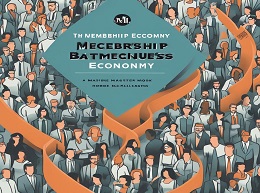The Membership Economy: Find Your Super Users, Master the Forever Transaction, and Build Recurring

Unpacking "The Membership Economy": A Comprehensive Guide to Building Recurring Revenue
"The Membership Economy: Find Your Super Users, Master the Forever Transaction, and Build Recurring Revenue" by Robbie Kellman Baxter is a groundbreaking book that delves into the transformative power of membership models in modern business. This detailed review explores the book's key concepts, practical strategies, and illustrative examples, providing a thorough understanding of how businesses can harness the membership economy to achieve sustainable growth.
Understanding the Membership Economy
The membership economy is a business model shift from transactional to relationship-based interactions, focusing on long-term customer engagement and recurring revenue.
The Concept of the Forever Transaction
At the core of the membership economy is the "forever transaction," a mutually beneficial ongoing relationship between a business and its customers. This concept emphasizes the importance of delivering continuous value to retain customers over time.
Example: Netflix exemplifies the forever transaction by continuously providing new and engaging content to keep its subscribers entertained and loyal.
Finding and Nurturing Super Users
Super users are highly engaged and loyal customers who derive significant value from the membership and, in turn, provide immense value to the business.
Identifying Super Users
The book outlines strategies for identifying super users, such as analyzing usage patterns, engagement metrics, and feedback. These users often exhibit behaviors like frequent use, active participation in community forums, and advocacy for the brand.
Example: Apple’s iPhone enthusiasts, who not only purchase the latest models but also participate in product forums and promote the brand through word-of-mouth, are prime examples of super users.
Engaging and Rewarding Super Users
Once identified, super users should be engaged and rewarded to enhance their loyalty and advocacy. The book suggests personalized communication, exclusive content, and special recognition as effective methods.
Example: Sephora’s Beauty Insider program offers exclusive events, early access to products, and personalized recommendations to its top-tier members, ensuring they feel valued and special.
Building a Subscription-Based Model
Transitioning to a subscription-based model requires a strategic approach that includes designing compelling membership offers, setting up efficient billing systems, and ensuring ongoing member satisfaction.
Designing Compelling Membership Offers
The book emphasizes the importance of crafting offers that resonate with the target audience. This involves understanding customer needs, creating value propositions, and setting appropriate pricing tiers.
Example: Amazon Prime combines fast shipping, exclusive deals, and access to streaming services, creating a comprehensive value proposition that appeals to a wide range of customers.
Implementing Efficient Billing Systems
A seamless and transparent billing system is crucial for maintaining customer trust and satisfaction. The book highlights the need for easy sign-up processes, flexible payment options, and clear communication regarding billing.
Example: Spotify’s user-friendly subscription management system allows users to easily upgrade, downgrade, or cancel their subscriptions, minimizing friction and enhancing user experience.
Creating and Sustaining Engagement
Sustaining engagement is key to retaining members and maximizing lifetime value. The book provides strategies for fostering a sense of community, delivering continuous value, and utilizing data-driven insights.
Fostering a Sense of Community
Building a community around the membership can enhance engagement and loyalty. The book suggests facilitating member interactions through forums, events, and social media groups.
Example: Peloton’s digital community allows users to connect, share their workout progress, and participate in live classes, creating a sense of belonging and motivation.
Delivering Continuous Value
To retain members, it is essential to consistently deliver value that meets their evolving needs. The book advises regular updates, personalized experiences, and proactive customer support.
Example: LinkedIn Premium offers continuous value through personalized insights, advanced job matching, and professional development resources, keeping subscribers engaged and satisfied.
Leveraging Technology and Data
Technology and data play a critical role in optimizing the membership experience and driving business growth. The book discusses the importance of leveraging these tools for personalization, engagement, and operational efficiency.
Personalization Through Data
Using data to personalize the membership experience can significantly enhance customer satisfaction and loyalty. The book highlights the need for collecting and analyzing user data to tailor content, recommendations, and interactions.
Example: Netflix uses sophisticated algorithms to analyze viewing habits and preferences, providing personalized content recommendations that keep users engaged.
Enhancing Operational Efficiency
Technology can streamline operations, reduce costs, and improve service delivery. The book suggests implementing automated billing, customer relationship management (CRM) systems, and analytics platforms.
Example: Salesforce’s CRM system helps businesses manage customer relationships, track interactions, and analyze data to improve service delivery and operational efficiency.
Measuring Success and Iterating
The final chapters of the book focus on measuring the success of the membership model and continuously iterating to improve and adapt.
Key Performance Indicators (KPIs)
The book outlines essential KPIs for evaluating membership success, including customer acquisition cost (CAC), lifetime value (LTV), churn rate, and engagement metrics.
Example: A SaaS company might track LTV to CAC ratio to ensure that the value generated from a customer over their lifetime exceeds the cost of acquiring them, indicating a sustainable business model.
Continuous Improvement
To stay competitive and meet changing customer needs, businesses must adopt a mindset of continuous improvement. The book recommends regular feedback loops, testing new ideas, and being agile in responding to market trends.
Example: Adobe transitioned from a perpetual licensing model to a subscription-based model with Adobe Creative Cloud. By continuously updating and improving their software based on user feedback, they ensured sustained value for subscribers.
Embracing the Membership Economy
"The Membership Economy: Find Your Super Users, Master the Forever Transaction, and Build Recurring Revenue" is an invaluable resource for businesses looking to transition to or optimize a membership-based model. By focusing on long-term customer relationships, delivering continuous value, and leveraging technology, businesses can achieve sustainable growth and build a loyal customer base.
For any business aiming to thrive in today’s economy, adopting the principles and strategies outlined in this book can lead to significant competitive advantages. Whether you are a startup or an established company, "The Membership Economy" provides the insights and tools necessary to build a successful membership model that drives recurring revenue and long-term success.













